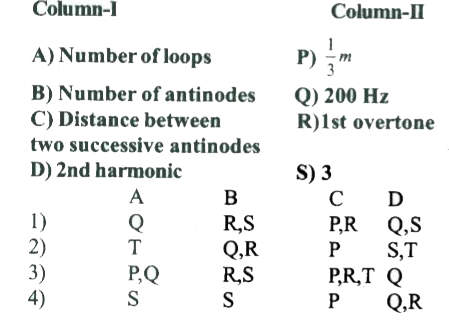A string fastened at both ends has successive resonances with wavelengths of 0.54 m for nth harmonic and 0.48 m for the (n+1) th harmonic and 0.48 m for the (n+1) th harmonic.
(a) Which harmonics are these?
(b) What is the length of the stirng?
(c) What is the wavelength of the fundamental frequency?
The correct Answer is:A, B, C, D
(a) nλ12=l
∴n(0.54)2=l
or n=l0.27
Similarly, (n+1)λ22=l
or (n+1)(0.48)2=l
or (n+1)=l0.24
From Eqs. (i) and (ii) we have,
nn+1=89
(b) From Eq. (i),
l=(0.27)n
=0.27×8
=2.16m
(c) λ2=l (Fundamental)
∴λ=2l=4.32m.
Topper's Solved these Questions
- SUPERPOSITION OF WAVESBOOK - DC PANDEYCHAPTER - SUPERPOSITION OF WAVESEXERCISE - Subjective Questions
6 Videos
- SUPERPOSITION OF WAVESBOOK - DC PANDEYCHAPTER - SUPERPOSITION OF WAVESEXERCISE - Level 2 Single Correct
15 Videos
- SUPERPOSITION OF WAVESBOOK - DC PANDEYCHAPTER - SUPERPOSITION OF WAVESEXERCISE - Objective Questions
1 Videos
- SOUND WAVESBOOK - DC PANDEYCHAPTER - SOUND WAVESEXERCISE - Exercise 19.7
4 Videos
- THERMOMETRY THERMAL EXPANSION AND KINETIC THEORY OF GASESBOOK - DC PANDEYCHAPTER - THERMOMETRY THERMAL EXPANSION AND KINETIC THEORY OF GASESEXERCISE - Medical entrance gallary
30 Videos
Similar Questions
An organ pipe has two successive harmonics with frequencies 400 and 560HZ. The second of sound in air is 344m/s.
(a) Is the an open or a closed pipe?
(b) What two harmonics are three?
(c ) What is the length of the pipe?
View SolutionThe equation for the vibration of a string, fixed at both ends vibrating in its third harmonic, is given by y=(0.4cm)sin[(0.314cm−1)x]cos[f(600πs−1)t].(a) What is the frequency of vibration ? (b) What are the positions of the nodes ? (c) What is the length of the string ? (d) What is the wavelength and the speed of two travelling waves that can interfere to give this vibration ?
View Solution
Knowledge Check
A string fastened at both ends has successive resonances with wavelengths of 0.1 m for mth harmonic and 0.08 m for (m+1)th harmonic.
The value of m isA3B4C5D6A string fastened at both ends has successive resonances with wavelengths of 0.1 m for mth harmonic and 0.08 m for (m+1)th harmonic.
the length of the string isA0.2mB0.4mC0.6mD0.8 mIf a guitar string is 0.5 m long, what is the wavelength of its third harmonic?
A0.25 mB0.33 mC0.5 mD1 m
For a stationary wave set up in a string having both ends fixed, what is the ratio of the fundamental frequency to the third harmonic?
View SolutionThe frequency of the 5th harmonic of a pipe closed at one end is 680 Hz. If the speed of the sound is 340 m/s then the length of the pipe will be
View SolutionA wire fixed at both ends is 1.0 m long and has a mass of 36g. One of its oscillation frequencies is 250Hz and the next higher one is 300 Hz.
(a) Which harmonics do these frequencies represent?
(b) What is the tension in the wire?
View SolutionA string of length 1m stretched at both ends vibrating with frequency 300Hz which is 3 times the fundamental frequency

View SolutionIf a string fixed at both ends, vibrates in its fourth harmonic, the wavelength is 15 cm. What is the length of the string ?
View Solution
